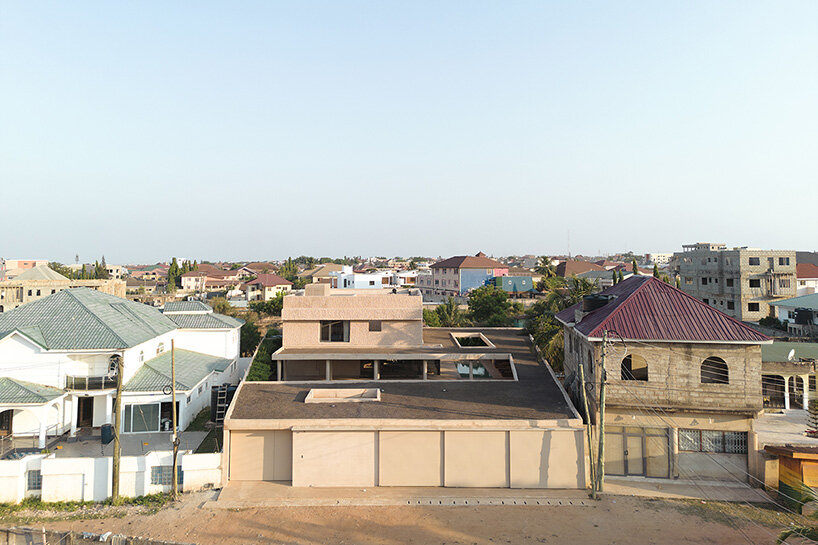a peaceful artist residency opens in accra
Ghanian artist Amoako Boafo has collaborated with architecture studio DeRoché Strohmayer to bring life to dot.ateliers | Ogbojo — the latest artist residency in a series which aims to enhance the creative ecosystem of Accra, Ghana by addressing gaps in its infrastructure. Drawing from Boafo’s personal experiences and those of other artists, the initiative emphasizes community engagement across different regions and creative subgroups, and showcases the advantages of a career in the arts. The project is led by artists for artists, and underscores the importance of art and the artist’s role in community development and empowerment.
The newly completed dot.ateliers emerges as a dedicated haven for writers, curators, and filmmakers. This adaptive reuse project features courtyards and voids at a range of scales, which create spaces of stillness amidst the vibrant urban context outside. Both residential and collaborative areas are infused with nature, and offer a peaceful retreat for creative minds — all behind a subtle sculptural gesture to the street.

images © Julien Lanoo
the mission of artist amoako boafo
dot.ateliers | Ogbojo represents an artistic ‘beacon’ which will provide a space where creativity can thrive in Accra, Ghana without restrictions. Situated at the heart of an artistic collaboration, its inaugural program, STILL.dot, will soon be launched in partnership with acclaimed artist Ayana V. Jackson and the STILL Art Residency Program based in Johannesburg, South Africa. The initiative brings together artists Ayana V. Jackson and Amoako Boafo to address the critical needs of artists, offering insights and support tailored to their specific challenges. Jackson’s reflection on the artist’s journey, highlighting the need for respite and renewal, underscores the residency’s mission to provide a cooperative approach to artistic sustenance.
‘dot.ateliers was founded with an understanding of the need for supporting infrastructure, starting with creating spaces for artists,’ founder Amoako Boafo says. ‘This initiative aims to provide resources and environments where artists can thrive creatively.’
artist Amoako Boafo founded dot.ateliers to address infrastructure gaps and foster community engagement
deroché Strohmayer Designs for work and Leisure
Among the emerging production-led artist residencies in West Africa, dot.ateliers | Ogbojo stands out for its focus on rest and reflection. Located on the outskirts of the city, this creative hub combines living and informal collaborative workspaces with natural surroundings, promoting a holistic approach to creativity. The facility, initiated by Amoako Boafo and designed by DeRoché Strohmayer, is designed for invited intellectuals and artists to live, ponder, and rest over several months, fostering a supportive environment for creative incubation.
‘For me, well-designed spaces are those that are pleasing, serve their purpose, and tell a story,’ Boafo continues. ‘What is unique about dot.ateilers | Ogbojo is its domestic and homey character, creating an environment that feels safe, encourages rest, and inspires new thinking.’
dot.ateliers | Ogbojo is designed by DeRoché Strohmayer as a serene retreat for writers, curators, and filmmakers
inside dot.ateliers | ogbojo
With architecture by DeRoché Strohmayer, dot.ateliers | Ogbojo emphasizes respite and regeneration through its adaptive reuse approach, characterized by courtyards and voids of various scales. These spaces offer calm and privacy within a dynamic urban context. The architectural expression balances institutional and domestic elements with strategic massing, lush vegetation, and refined finishes. The project retains the existing building while adding ancillary structures, connected through gardens and a canopy that promotes outdoor living. The central courtyard serves as a flexible space for contemplation, leisure, and communal gatherings for creatives.
‘dot.ateliers | Ogbojo is attuned to the complexities of artistic production and urban development taking place in Accra today,’ explain architects Glenn DeRoché and Juergen Strohmayer. ‘An unexpected sense of calm pervades the project, which is the atmosphere we were aiming for in this post-artist-residency retreat.’
featuring courtyards and voids, the design balances studios and living space
The interiors of dot.ateliers | Ogbojo are curated for a fluid flow between spaces. Ground-floor rooms feature picture windows with views of themed landscapes, maintaining a continuous connection with nature. The two-story structure houses communal areas like living rooms, a library, a gym, and a kitchen on the ground floor, while private ensuite rooms occupy the first floor. Light shafts throughout the building ensure ample natural light without direct heat gain, framing views of the gardens and sky.
‘Choregraphing a unique sequence of spaces specific to the residency programming, which are characterized by core space-making principles — Form, Volume, Light, Material — is one of the exciting experiences of the dot.ateilers | Ogbojo project,’ the architects continue. ‘Architecture has a responsibility to not only provide shelter for a specific need or function, but to do so with an intentionality to evoke a sense of emotion from the users. That is what the residency seeks to do for the various artist who occupy the space.’
the artist residency provides tranquil residential and collaborative spaces for creative minds
Together with its spirit of adaptive reuse, the architectural design of dot.ateliers | Ogbojo integrates a number of passive sustainable strategies. These include minimizing heat gain, retaining stormwater for irrigation, and making use of solar energy for lighting and water heating. The new canopy moderates light and provides covered walkways, while deep wall assemblies reduce heat gain through window openings. Large operable windows enable cross ventilation, reducing the need for air conditioning. Locally produced, low-carbon concrete and artisanal earth-render methods reflect Ghanaian construction traditions, while interior finishes with locally sourced walnut timber reinforce the project’s harmonious character and sustainability principles.